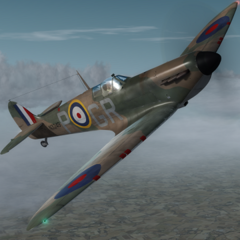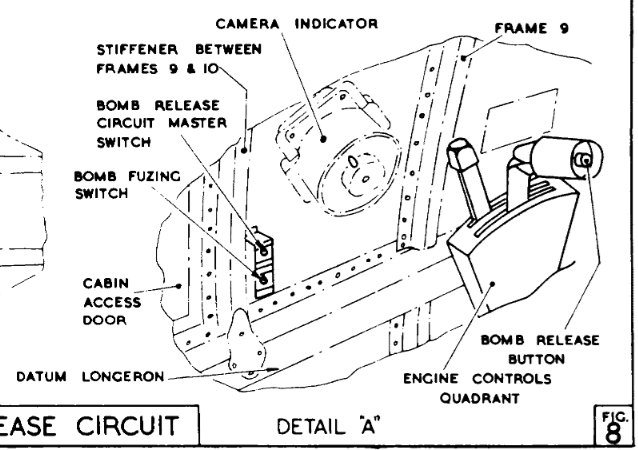-
Posts
386 -
Joined
-
Last visited
Content Type
Profiles
Forums
Events
Everything posted by Skewgear
-
The engine limitations in the manual were for the real thing, to promote longer times between overhaul for the engine. In DCS you can thrash it, it's only got to last an hour or two. That aside, your Spitfire will be much happier being flown at book settings. Max continuous is a good combat cruise setting. Transit cruise, you can pull the revs back to around 2,350rpm and leave the boost somewhere around 0-2lbs. It'll positively sip fuel at that sort of power setting. In combat I keep max power use to a minimum, sitting around 14lbs unless I need the speed or acceleration. Watch the rad temp, 115C is tlwhere you need to consider throttling back. However, you can hit up to 125C without destroying anything. Key to engine life is oil pressure. Anything above 100psi, throttle back.
-
I don't think the issue is the gun, it's the damage models of whatever you're firing the gun at. The Spitfire gets properly clobbered by the 30mm every time unless you're unlucky and only clip a wing. Even then, a hit on the left radiator area invariably vents all the oil through the oil cooler for a mission kill. The Mosquito catches fire as soon as you look at it. I've blown the odd P-51 tail off but mostly that seems able to absorb several hits. The P-47 is very difficult to inflict meaningful damage on.
-
It's fine as is. The cooling system keeps a constant low level of flow going even when the thermostatic valve is "closed", else no heat would be removed from the engine at all.
-
Our Spitfire lacks the bomb control panel it should be fitted with. Currently there are no bomb release controls of any kind other than the release button in the throttle handle. All bombs release simultaneously and there is no emergency jettison or fuzing. This is not modelled, meaning bomb fuzing and release is not modelled correctly in-game. The Mk.IX was fitted with a six-way bomb fuze selector. This is described in the Spitfire IX manual AP 1565J Volume 1, Section 1, Amendment List 14. (the AL14 insert is attached below) Extra information is available in the Spitfire VIII manual, AP 1565H Volume 1 Section 6 (electrical and radio wiring and servicing), which describes the same switchbox and gives details of the electrical arrangements powering it: The illustration of the switchbox from AP 1565H is attached below, as is the illustration of the equivalent fitting for the Mk.V Spitfire. The Mk.IX switchbox is fitted in the same location. The full extract from AP 1565J Vol 1 AL14 detailing the bomb switchbox is here: https://forum.dcs.world/applications/core/interface/file/attachment.php?id=81126
-

4YA Project Overlord WW2 One Life Event
Skewgear replied to Skewgear's topic in Tournaments & Events
We stopped posting on the forums - didn't really seem to generate any interest and it was just another channel to keep on top of. With more than 60 pilots in the last event a couple of weeks ago we have plenty enough to keep us busy! Our event promotion is all on our Discord now. Link to that is on www.projectoverlord.co.uk -

Engine RPM telemetry not showing at low throttle
Skewgear replied to FinalGlide's topic in Bugs and Problems
If realism is your thing, it's worth knowing that tickover (ground idle) in the Spit means selecting 1,200rpm. You wouldn't leave the engine at idle (throttle against the stop) because that promotes plug fouling. -
The drift meter/recorder will be an excellent navigation addition. With any kind of crosswind the Mosquito really likes to weathercock into it so calculating drift for a flight of any distance at all becomes really important. Looking forward to this.
-
If you want to try advanced radio navigation using the DF equipment in the Mosquito FB VI that we have, the Project Overlord multiplayer server has three tunable radio beacons. A skilled navigator can thus pinpoint your location anywhere on the Normandy map, any altitude, any time.
-
Ugra Media has a static Liberty Ship model baked into the Normandy 2 map at some ports. Perhaps ED could strike a deal to include that and other Ugra static models in the WW2 asset pack?
-
So you've built that brilliant cockpit and panel setup ... but then you put on a VR headset so you can't see any of it?
-
We have introduced three new historical navigation beacons across the Normandy map for use by player Mosquito crews. The old Ste Croix and Needs Oar Point beacons have therefore been decommissioned with immediate effect. The new beacons are marked on the F10 map in all missions; a sample is shown below. The beacon details are as follows: Bernay Elektra-Sonne BL -... .-.. 307kc/s Whitlands (Lyme Regis) RDF D -.. 3.8Mc/s Haine (Manston) RDF F ..-. 3.6Mc/s All missions have had minor performance improvements (removal of unused elements such as redundant triggers and trigger zones) made. 24th June 1944 v5.3.5 has also had the new PO warehousing system rolled out. This includes supply convoys driving to and from selected airfields. (Yes, you can destroy these convoys and cut off the airfield supplies!) Player count remains capped at 45 on the PO server as a temporary measure, hopefully until ED publishes a fix for the current multiplayer server performance problems. See you in the skies! The Project Overlord Team https://www.projectoverlord.co.uk/documents/mission-update-radio-navigation-beacons/
-
Minimum single engine speed is around 150mph. If you are slower than that, you will crash. Lose height to regain speed. There is no going around from a poor approach if your speed is below 150mph. Accept you are going to land on the ground in front of you once your airspeed is below that critical point. Do not lower the gear until you are committed to landing, and remember it takes longer to extend and lock because you'll only have one hydraulic pump. Maximum power on the remaining single engine is 12lbs. More than that and you will exceed the combined rudder and trim authority needed to overcome the asymmetric thrust, meaning you will crash. The Mosquito cannot maintain height on one engine with the dead engine's prop unfeathered. If you cannot feather it, you will stall and crash. Dump all extra weight (bombs and drop tanks) as soon as you can after shutting down and feathering a dying or dead engine. Remember to shut the bomb doors and the radiator flap for the dead engine. Don't be afraid to make an early decision to put it down in a field. Better to survive the inevitable crash than not.
-
How long did it take?
-

Please Update the Kneeboard Functionality (Especially for WWII)
Skewgear replied to TPrince's topic in DCS: The Channel
If we had the option to turn it off server side then on Project Overlord we would turn it off. But it's not an option, so we can't. That said, it's the one crutch we have for newbies. Difficult enough flying with zero external views or the F10 gods eye mode if you're used to that. -
The first Second Tactical Air Force Mosquito squadron to move to the continent was No.604, who moved into Maupertus in the final days of July 1944 for night fighter operations. Another squadron moved into Carpiquet in late August but again, they were nightfighters. Project Overlord stops at mid August before any FB.VI squadrons moved across. We decided to turn a blind eye to the exact type and positioned Mosquitos at Maupertus in late July missions onwards. There are errors in this table rescued from a very old and long dead website but about 90% of it is accurate for dates and locations: https://www.projectoverlord.co.uk/history/second-tactical-air-force-order-of-battle/
-
2350rpm and +7lbs boost is an economical way of crossing the Channel. Burns about 30 gallons per tank from takeoff to feet dry at the far end while flying at 50ft, so about 110nm. There's no reason you couldn't drop the revs further. The Spitfire happily cruises forever at 2000rpm/+2lbs, for example. In the Mossie I'd pull the throttles well back, pull the revs to 1850rpm and then throttle up to +7lbs in weak mixture for max fuel economy. Otherwise I follow the pilots' notes, remembering to convert knots to statute mph for the speeds because the 1950 edition seems to be at odds with the actual aeroplane's units. The key thing is to watch the oil pressure to keep it below ~110psi and avoid going over 8lbs boost. Our simulated Merlin seems happiest with lean mixtures (at and below 7lbs in auto mixture) at any low rpm setting.
-
Thanks for this. Can't promise anything but your track does clearly show a difference between shutting down from hot start spawn and shutting down after a player engine start.
-
For those saying the engines should splutter and backfire a bit on shutdown, it seems the real aircraft shuts down very quickly indeed with barely a pop:
-
RAF Hartfordbridge (today known as Blackbushe) would be a great addition because it was the base of 88 Sqn, one of the RAF's A-20 squadrons. RAF Lasham was also a major Mosquito base. Seconded on RAF Thorney Island. However, we should suggest some USAAF airfields. We really are lacking in those.
-
Project Overlord has had wake turbulence turned on for a few months now. For a long time we believed it would be a performance hog, then we did some public experiments and discovered the impact was negligible on the server and players reported little negative effect on their systems. If I remember rightly it's a forced server side setting, so everyone experiences the same when they fly with us. It is not enabled on the 4YA WW2 training server, however.
-
Yes, I have.
-

Looking for a real Mosquito compass deviation card, anyone?
Skewgear replied to Lau's topic in DCS: Mosquito FB VI
Bah. Yes I meant declination, not deviation! -

Looking for a real Mosquito compass deviation card, anyone?
Skewgear replied to Lau's topic in DCS: Mosquito FB VI
Declination (edit, not individual compass deviation, see below) is modelled according to mission date and variation rate over time. Check the mission editor compass rose for the default June 2016 date when you open the editor, and then check what it says after you change the date to July 1944. Individual airframe speed variation definitely seems modelled in the Mossie (try flying close formation on a Channel transit with other players). As mentioned, my belief is the card we see on the left sidewall (I.e. Next to the pilot's compass) is the mag dev card. Placing the RDF deviation card there would make even less sense than placing the main compasses out of sight of the navigator... -

Looking for a real Mosquito compass deviation card, anyone?
Skewgear replied to Lau's topic in DCS: Mosquito FB VI
There already is a deviation card in the Mosquito cockpit. Left sidewall, in line with the port engine oil pressure warning light.






